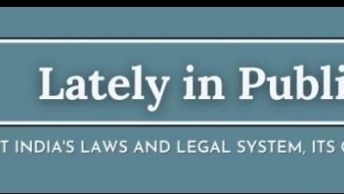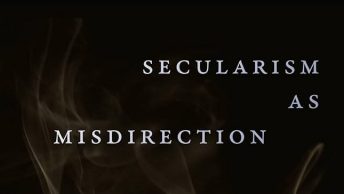Rajasthan v. Union of India, the Supreme Court has by a majority of 2-1
upheld the constitutionality of The Right of
Children to Free and Compulsory Education Act, 2009. Chief Justice Kapadia
Justice Swatantra Kumar formed the majority and Justice Radhakrishnan
dissented. The central issue before the Court was whether the State, under
s.12(1)(c) of the Act, could require unaided schools (minority and
non-minority) to set aside 25% of their seats for children between 6-14 years
from disadvantaged sections. All 3 judges agreed that such a requirement on
unaided minority schools violated the protection granted to religious and
linguistic minorities in Article 30(1). On the question of whether it would be
constitutional to impose such a requirement on unaided non-minority schools, the
majority found it to be permissible whereas Justice Radhakrishnan declared that
a such requirement violated Article 19(1)(g) of the Constitution.
conclusions on unaided non-minority schools is fascinating and I hope to
briefly discuss some of those themes in this post.
non-minority schools through an ordinary law?
minority opinion is at its sharpest. Justice Radhakrishnan is of the view that
since the scope of the protection enjoyed by unaided institutions under Article
19(1)(g) was clarified by a 11-judge bench in T.M.A Pai before the 86th Constitutional Amendment was
passed by Parliament, the absence of a specific provision in Article 21-A
giving the State such a power would preclude the imposition of the 25%
requirement through an ordinary law.
Kapadia, is that the judgment in TMA Pai
cannot be used for such a reading because it was a decision that defined the
scope of Article 19(1)(g) in the context of reservations in private higher
education institutions under Article 15. The relationship between a law enacted
under Article 21-A and Article 19(1)(g) according to the majority cannot be
controlled by the interpretation given in TMA
Pai.
Radhakrishnan’s dissent. Indira Jaisingh argued that the removal of the
specific provision [draft Article 21A-3] that prohibited the State from
imposing any obligation on unaided schools was indicative of Parliament’s
intention. Justice Radhakrishnan’s argument is that Parliament’s decision not
to include a specific provision giving the State the power to regulate unaided
non-minority schools in such a manner in light of the decision in TMA Pai leads to the opposite
conclusion.
the general public for the State under Article 19(6) to require schools to set
aside 25% of their seats for children from disadvantaged section as a condition
for granting recognition. However, for Justice Radhakrishnan it is
impermissible to attach such conditions for granting recognition. Though the
decisions in TMA Pai and Inamdar certainly permit the State to
regulate certain matters in unaided non-minority institutions through the
process of granting recognition, the requirement in the Right to Education Act,
2009 certainly falls outside the scope of such permissible regulation.
mandate of the State to enforce the right to education under Article 21-A and
the rights of the schools before the Court under Article 19(1)(g) leaves much
to be desired. The majority opinion states that requirement to admit 25% of
Class I students from disadvantaged sections cannot be seen as a constitutional
transgression because the aim is to remove barriers for children who cannot
access schools and not to restrict the freedom guaranteed under Article
19(1)(g). It does not tease out the implications for balancing the rights in
question when stating that the Court is taking a child-centric approach in this
case while it was an institution-centric approach in TMA Pai and Inamdar. It
certainly does not explain why the State has greater lee-way in restricting the
freedom under Article 19(1)(g) while providing for special measures in the
context of primary education (to a wide range of beneficiaries) than when
trying to provide reservations for OBCs and SC/STs in unaided higher
educational institutions in the pre-Article 15(5) days. Undoubtedly a
constitutional response can be constructed but unfortunately the majority opinion
does not offer it.
Materials
not transfer its obligation to provide free and compulsory education to private
parties. Justice Radhakrishnan refers to the arguments raised on the horizontal
application of rights in the Indian Constitution and the State having the power
to place such a requirement on private parties through a combined reading of
Articles 21-A and 15(3). Justice Radhakrishnan is of the view that there can be
no positive duties imposed on private parties in the realisation of
socio-economic rights and the role of private parties is limited to negative
duties to not infringe or take away the guaranteed rights. In support of his
argument that the positive obligation to implement socio-economic rights is
solely on the State, Justice Radhakrishnan draws upon the Supreme Court’s
jurisprudence on the right to food, health, shelter etc. in addition to foreign
cases like Soobramoney, Grootboom and TAC from the South African Constitutional Court and the
decision of the Tribunal Supremo de Venezuela in Cruz del Valle Bermudez.
21-A contemplates the enforcement of the right to primary education through a
law, the State has the power and the discretion to determine the contents of
the law, subject to satisfying the test of reasonableness. For the majority,
the Act clearly satisfies the test of reasonableness under Articles 19(1)(g)
and 14, and therefore there is no obstacle in placing a positive obligation on
a private party while realising the right to education.






I have not seen the following two points addressed anywhere. Perhaps the authors/readers of this blog have thought of them.
1. How is `weaker section' defined in this context? A family with an annual income of say 3 lakh (starting college lecturer) is not normally considered to be part of the weaker section. But such a family would find it impossible to send their children to a school whose annual `cost' per child is 1 lakh. If such children are not allowed to use the reservation under RTE, but children with a lower family income are allowed, is that discrimination?
2. It seems that private schools will raise their fees to fund the seats reserved for students who cannot pay their fees. So those who send their children to private schools will have to pay extra, essentially in support of a government program on education. Thus this in effect becomes an additional `education tax'. But the same people are also paying an `education cess' with their income tax. Is this not double taxation by a different name?
Thank you for the post.
In my mind, the fourth argument is the key argument – Horizontal Application of Rights and the Use of Comparative Materials.
Justice Radhakrishnan has clearly given the most realistic/purposive interpretation to the provisions.
Having heard the arguments (in part), in person (although I have not read the judgment), I do not think the majority has given a logical analysis for dissenting from the view taken by Justice Radhakrishnan.
On what basis can obligations of the State (both in the form of fundamental duties and Article 21A – imposing a positive obligation on State), be shifted to private parties, for non-aided private institutions?
Even during the arguments in court, Justice Kapadia had no counter to these arguments made by the counsel for private unaided schools.
I would be grateful if someone could highlight a plausible explanation for a disagreement with Justice Radhakrishnan's view.
This judgment could have far reaching consequences on several aspects.
Reservations in public employment – On the same logic of discharging state functions/duties through forcing private institutions, could the government force private sector to reserve jobs for the weaker sections of the society?
Amitabha and Renu — Thanks for you comments and questions.
In response to Amitabha's questions:
1) 'Children belonging to weaker sections' is essentially a poverty-based criterion. In the rules notified by various state governmenst, they use the BPL criteria that exists in that particular state.
I recognise, however, that your question relates a person belonging to the 'weaker section' being able to send her daughter to the most elite school in a locality but someone who does not fall within that definition cannot send her daughter to the very same school because of her income constraints.
There is a certain intuitive appeal to your question but I don't think it constitutes discrimination, or rather it does not constitute "unfair discrimination". If you were to understand discrimination as merely any difference in treatment, yes — the situation you describe is discrimination. But what the law prohibits is unfair discrimination and not all difference in treatment is unfair. To a certain extent, fixing the BPL is an arbitrary exercise but an inevitable one. But once that category is created, it would only be fair to give individuals who fall within that category certain extra opportunities that are not available to those outside that category.
2. I don't think that the 'possibility' of private schools raising their fees would amount to a tax on the parents. Firstly, the state is sharing part of the costs and secondly, there is no compulsion on the schools to raise their fees because the argument might well be that private schools are only required to reduce their profit margins. It would, I assume, depend on the dynamic between the parents and the school management whether the school is allowed to raise the fees to keep up their profit margin.
In response to Renu's question:
1) Justice Radhakrishnan is correct in highlighting the fact that the dominant discourse on enforcement of socio-economic rights in India and in South Africa has been that the obligation has been on the State. However, does that mean that the State under the Indian Constitution cannot require private parties to share its obligation to implement socio-economic rights? I think there are constitutional means through which this obligation can be imposed on unaided non-minority schools.
Through the 93rd Amendment, an obligation was imposed on private insitution to provide reservations by inserting article 15(5) and thereby restricting the rights available under 19(1)(g). Similarly, a constitutional amendment for such a measure as contemplated under the RTE Act would be a legitimate restriction of the 19(1)(g) rights of private schools. Ofcourse, the problem in this case was that it was done through an ordinary legislation and Justice Radhakrishnan's analysis is spot on.
Would such a constitutional amendment violate the basic structure? I think that would be a difficult argument to pull off. One would assume that the protection under 19(1)(g) will not lend itself to a successful basic structure argument. However, if the constitutional amendment tried to bring in unaided minority schools as well, it might well run into a successful basic structure challenge that invokes the protection granted to linguistic and religious minorities under article 30(1).
Therefore, I wouldn't read Justice Radhakrishnan's opinion as saying that the State cannot place such an obligation on unaided non-minority schools under any circumstance. In light of relevant precedent, I read his opinion as saying that it could not have been done through an ordinary legislation as in this case.
Anup
just some theoretical considerations in support of anup's responses.
1. surely the least well-off have the first claim to a society's welfare budget. it would mean that the ones just above them (the less well off) would have to wait longer. but at least in principle, after the welfare intervention, the less well off will become the new least well off. so their turn will come, in proportion to the urgency of their need. see parfit's seminal paper on prioritarianism: Parfit, Derek. 'Equality and priority', Ratio, vol. 10, no. 3 (December, 1997), pp. 202-221.
2. i don't see what the principled objection to horizontal application is. i can think of many pragmatic reasons why (to take renu's example) imposing reservation duties on the private sector may be a bad idea. but i dont see any prima facie reason why non-quota based affirmative action duties cannot be imposed.
look at it this way: we already accept progressive taxation. that signifies a rejection of libertarianism. most liberal regimes which accept progressive taxation accept that we (as private individuals) have duties towards the welfare of the disadvantaged in our communities. these duties are roughly in proportion to our own degree of affluence. so the state cannot make any demands on me if i am struggling myself (or, to use Joseph Raz's terminology, if I myself did not have 'access to an adequate range of valuable options'). But if i am relatively well off, progressive taxation expects me to give some of what i have away for the benefit of those who don't have enough.
if we accept this principle in the context of income taxation, where each individual is normally expected to work for her own well being, i find it surprising that we find it harder to accept the idea in the context of institutions like schools (who, even when private, are not expected to have profit making as their primary objective).
PS – Just read Mehta's piece linked by Arun, and agree when he says:
'In funding by taxation we usually adopt progressive taxation. In the current scheme there is a real danger that a proportionately much larger burden may fall on relatively lower middle class parents than rich ones.'
As my previous comment said, the principled position should be that burdens must be proportionate to ability. It may be that the design of RTE Act violates this principle in putting the burden on the middle rather than the top of the class spectrum.